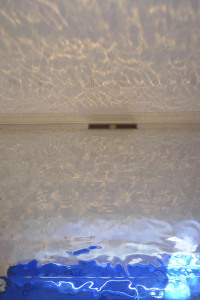Charles Matson Lume’s light installation opens January 15 in the ground floor gallery
Artist reception Monday, February 2nd from 4 pm – 6 pm with presentation by the artist at 5:30 pm
 Minnesota artist Charles Matson Lume spent two weeks in early January this year in the Center’s gallery creating and installing an exhibit whose subject is light. A special reception and presentation by the artist will take place on Monday, February 2nd as part of the Center’s Winter Light Festival. Charlie will talk about his work and have a slide show of other light installations he has done as well as tell about his upcoming work in Finland and Sweden scheduled to take place this summer. The presentation is a part of this year’s Winter Light Festival at the Center which will feature live music and award-winning films from the Rural Route Film Festival as well as Charlie’s light installation. The photograph shows one detail from a larger work that he created in 2014 while an artist in residence at the Center in 2014. Charlie is a professor of art at the University of Wisconsin, Stout.
Minnesota artist Charles Matson Lume spent two weeks in early January this year in the Center’s gallery creating and installing an exhibit whose subject is light. A special reception and presentation by the artist will take place on Monday, February 2nd as part of the Center’s Winter Light Festival. Charlie will talk about his work and have a slide show of other light installations he has done as well as tell about his upcoming work in Finland and Sweden scheduled to take place this summer. The presentation is a part of this year’s Winter Light Festival at the Center which will feature live music and award-winning films from the Rural Route Film Festival as well as Charlie’s light installation. The photograph shows one detail from a larger work that he created in 2014 while an artist in residence at the Center in 2014. Charlie is a professor of art at the University of Wisconsin, Stout.
“Death is the mother of beauty (for Wallace Stevens)” opens on Thursday, January 15 and continues through Saturday, Februray 28. There is no admission charge for this exhibition. The following essay is Charlie’s statement about his work in creating images of light:
With common, disposible materials made from our culture, I seek to highlight and re-engage our senses and the sense of the unreal. With these cultural artifacts I ask questions such as: How can light be manifest in new ways to show us its delight and power? How does light shape our experiences in the world? Can light be altered to show us our elemental needs? These are some of the questions that assisted in creating this art at the New York Mills Cultural Art Center. Indeed, how does light touch you?
The title of this exhibition, Death is the mother of beauty (for Wallace Stevens), is taken, in part, from a line in Stevens’ poem, Sunday Morning. The phrase, “Death is the mother of beauty”, affirms and highlights metaphorically the ephemeralness of light. To me, the statement reveals and points to the paradox of change and stasis which mirrors our relationship to light, especially the sun. It embodies the cyclic and blind relationship we have to the sun. It is with us every day, but we cannot look at it, thus, often forgetting about it. Nonetheless, we need it near.
The new art presented at the New York Mills Cultural Art Center is also centered on my experiences in Scandinavia during the summers of 1985, 2009, and 2012. During those trips I visited in total: Norway, Sweden, Iceland, and Denmark. On my first trip, I was a teenager playing soccer there and could sense both consciously and unconsciously the light’s distinctiveness in these countries, but it was not until I was trained as an artist and returned to Scandinavia that I could begin to fully understand and appreciate what I was experiencing, especially its light.
Additionally, this current work is based on my experience last winter and this winter as artist resident at the New York Mills Cultural Art Center. My goal while a resident artist was to pay attention to the light and notice how it was different from my experiences in Scandinavia. I also wanted to explore some of the history of New York Mills and its connection to Scandinavia via the Finnish migration to the area in the 1800s. I did some research and reading on the subject, but was also taken the “Polar Vortex” that landed on Minnesota in the winter of 2014. The low arc of the sun never seemed to generate heat or much brightness. Or the illumination that did occur was brief and hurried. Sometimes the summer light in Scandinavia provided little warmth too, although it lingered well past midnight. Illumination has often been associated with thoughts, while heat has been paired with the body’s activity. In my art at New York Mills, I found illumination in unexpected places and warmth from the people I met there.
As a final thought, the length of sunlight in a day matters to our species. The amount of sunshine we receive in a day matters. It matters because these facts shape our wellbeing and health. They shape our daily outlook and how we go about each day. Over time, short days and/or little sunlight can have powerful negative health effects on us mentally and physically. Our connection to the sun is so elemental it almost seems not worth mentioning. But that is my point. In our overheated culture, we have lost touch with this basic knowledge. We forget, at our own peril, that many cultures worshipped the sun.